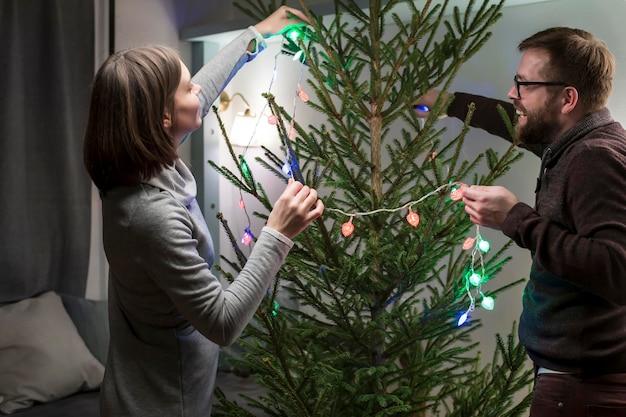When the festive season approaches and it’s time to decorate your home with twinkling lights, there’s nothing more frustrating than discovering that your Christmas lights are not working as expected. Understanding how to check your Christmas lights using a multimeter can save you from the disappointment of unlit light strands on Christmas trees. With this guide, you’ll learn the process of testing your lights to identify and fix issues, potentially saving your holiday display. Multimeters are versatile testers that can help you diagnose electrical problems easily and are key to keeping your festive spirits lit.
What You Will Need
Before embarking on your troubleshooting journey, it’s essential to gather up all the necessary tools and equipment for the task at hand. The most important item to have is, of course, a reliable multimeter. Even if you’re having trouble with lights not powering up or a new bulb just won’t light, a multimeter is going to be your best friend in diagnosing these common issues. Here’s what you’ll need:
- Multimeter (either analog or digital will suffice)
- Christmas light strands that are not working
- Safety gloves to protect your hands
- A comfortable and safe work area

Understanding Your Multimeter
To make sure you are using your multimeter correctly when testing your Christmas lights, you need a basic understanding of its functions and settings. The multimeter can test for various conditions but for our purposes, we will be focusing on continuity and voltage. Analog multimeters have a needle that moves to indicate readings, whereas digital multimeters provide a numerical display. For testing light strings, we’ll use the continuity setting which will help us determine if there are any breaks in the electrical path.
Preparing Your Christmas Lights for Testing
When preparing to check your Christmas lights, safety is the highest priority. Always begin by unplugging the strands from any electrical source to ensure that there’s no current flowing through the wires that could cause a shock. Inspect the entire length of the light strings for any obvious signs of damage, such as frayed wires or broken bulbs. After a visual inspection, untangle the strings so you can easily access each bulb if needed.
Step-by-Step Instructions to Test Your Christmas Lights
First, ensure your multimeter is functioning properly by checking its battery and then setting it to the continuity test option, which might be marked with a symbol resembling sound waves. A functioning multimeter should beep if the probes touch each other, indicating a complete circuit. This is the multimeter telling you that it’s ready for use.
Testing for Continuity
To check the continuity of your Christmas light strands, start by testing the fuses found in the plugs. Touch the probes to each end of the fuse; if the multimeter does not beep, it’s an indication that the fuse might have blown and needs replacing. Next, move on to the filament wires within each bulb, if accessible. If your multimeter does not beep at any point, this could be where your circuit is failing.
Detecting Faults in Individual Bulbs
If you’re dealing with a string of lights wherein only one or a few bulbs are not lit, you’ll want to test each bulb individually. Carefully remove a bulb from its socket and touch one multimeter probe to the bottom of the bulb and the other to the side. If your multimeter remains silent, then the bulb is faulty and should be replaced with a new bulb.
Troubleshooting Common Issues
Even with the right tools and methods, troubleshooting can bring forth challenges that require a bit of creativity and understanding to resolve. Here are some of the most common issues you might encounter while testing and fixing Christmas lights, and how best to approach them:
- If multiple bulbs are out, you could be dealing with more than one fault within the string.
- Sometimes, bulbs might not make proper contact in their sockets due to dirt or corrosion, so cleaning the contacts may fix the issue.
- Replacement bulbs should match the voltage of the original bulbs to prevent further complications between strings.

Maintaining Your Christmas Lights
Lastly, proper maintenance can go a long way in reducing future instances of non-working Christmas light strings. When storing your lights after the holiday season, consider winding them around a sturdy piece of cardboard or a reel to prevent tangling. Also, keeping the lights in a cool, dry place will protect the integrity of the wires and bulbs, making your next season’s setup smooth and merry.
| Issue | Possible Cause | Solution |
|---|---|---|
| Complete string of lights not working | Blown fuse or damaged wire | Replace fuse or locate and mend the damaged segment |
| Individual bulbs not lighting up | Faulty bulb or poor socket contact | Replace bulb or clean socket contacts |
| Dim lights or fluctuating brightness | Insufficient voltage or overloaded circuit | Ensure use of correct voltage bulbs and limit strings connected |
Conclusion
In conclusion, using a multimeter to check and troubleshoot your Christmas lights may seem like a daunting task initially, but once you’re acquainted with the process, it will become an essential part of your holiday prepping. Not only does this simple tool help you pinpoint the problem areas within your strings of lights, it also enables you to ensure that your Christmas trees and festive displays will shine brightly throughout the holiday season. Regular checks and maintenance will uphold the longevity of your Christmas lights, allowing them to be a part of your joyous celebrations year after year.

FAQs
Q1: Can I check LED Christmas lights with a multimeter?
A1: Yes, LED Christmas lights can be checked with a multimeter. You will need to use the diode setting on your multimeter to test each LED bulb.
Q2: What does it mean if the multimeter doesn’t beep during a continuity test?
A2: If there’s no beep during a continuity test, it usually indicates a break in the circuit. This typically means there’s either a broken wire or a faulty bulb that requires replacing.
Q3: How can I prevent blowing fuses in my Christmas lights?
A3: To avoid overloading circuits and blowing fuses, do not connect too many strands of lights in one chain, and ensure that any faulty bulbs or wires are replaced promptly.
Q4: Should I test my Christmas lights before or after putting them up?
A4: It is best practice to test your Christmas lights before putting them up. This saves you the hassle of potential re-work if any issues are found.
Q5: Is there a risk of electric shock when testing Christmas lights with a multimeter?
A5: If you handle your multimeter correctly and follow safety precautions, there’s minimal risk of electric shock. However, always handle electrical devices with care to avoid any potential hazards.


